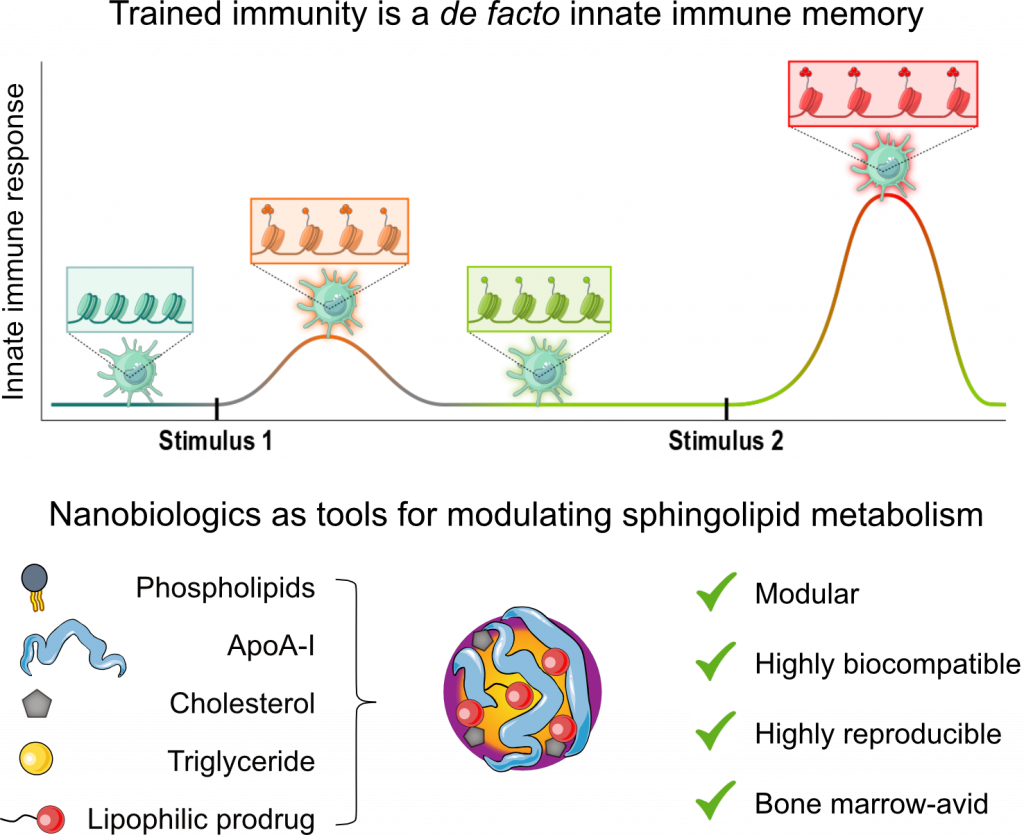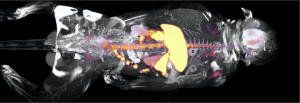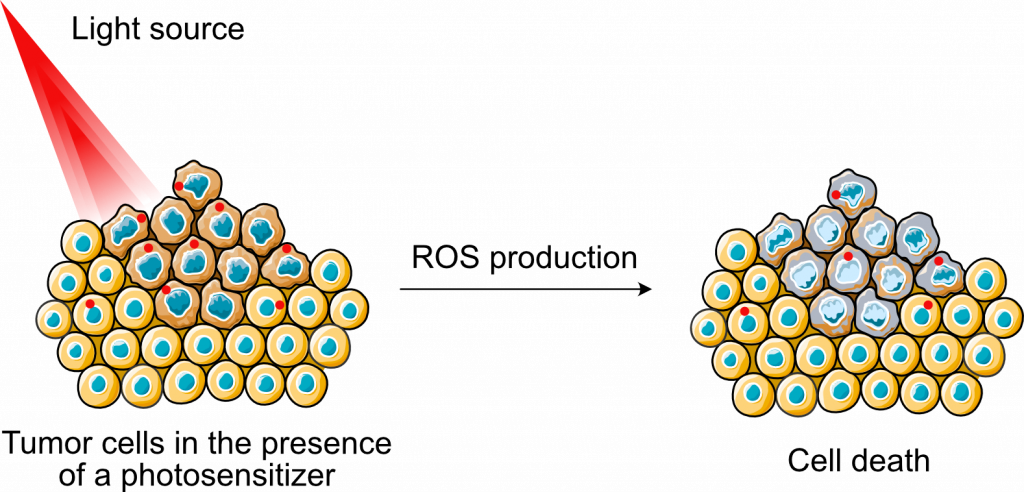Research topics
Introduction
Our research leverages the power of chemical synthesis to develop new tools for studying and modulating the innate immune system. This includes synthesizing novel drugs, nanotherapeutics, and imaging tracers, but also studying their behavior and effects in vivo. Our work has a strong emphasis on cancer, cardiovascular disease, and organ transplant rejection, for which we closely collaborate with immunologists and imaging scientists. Although our work predominantly focuses on mouse models, we also initiate the clinical translation of our technologies by experiments in rabbits, pigs, and non-human primates.
Therapeutically Targeting Trained Immunity
 Immunological memory has long been regarded as an exclusive hallmark of the adaptive immune system. However, this dogma has been challengde by a growing body of literature, demonstrating a de facto immune memory within the innate immune system. This innate immune memory, termed “trained immunity” is regulated through epigenetic changes in innate immune cells and their progenitors in the bone marrow. These modifications endow innate immune cells with the ability to ‘remember’ previous stimuli (e.g., an encounter with a pathogen or DAMPs) and hyperrespond to subsequent stimuli, both related and urelated. Judiciously regulating trained immunity in vivo holds great potential in treating conditions characterized by a dysregulated immune system, including cancer, infectious diseases, and organ transplant rejection. However, this strategy requires delivering trained immunity-regulating drugs to myeloid (progenitor) cells in the bone marrow. To achieve this, we have developed lipoprotein-based nanocarriers, termed ‘nanobiologics’. Nanobiologics have a high myeloid cell-avidity and can be loaded with diverse small molecule drugs using a prodrug strategy developed by us. We have extensively used nanobiologics to study and treat cancer, atherosclerosis, and organ transplant rejection in mice. Furthermore, we have demonstrated these nanotherapeutics’ clinical potential by using them to significantly proling graft survival in non-human primate models of heart and lung transplantation. Much of our nanobiologic research builds upon that of our former PI, Dr. Willem Mulder.
Immunological memory has long been regarded as an exclusive hallmark of the adaptive immune system. However, this dogma has been challengde by a growing body of literature, demonstrating a de facto immune memory within the innate immune system. This innate immune memory, termed “trained immunity” is regulated through epigenetic changes in innate immune cells and their progenitors in the bone marrow. These modifications endow innate immune cells with the ability to ‘remember’ previous stimuli (e.g., an encounter with a pathogen or DAMPs) and hyperrespond to subsequent stimuli, both related and urelated. Judiciously regulating trained immunity in vivo holds great potential in treating conditions characterized by a dysregulated immune system, including cancer, infectious diseases, and organ transplant rejection. However, this strategy requires delivering trained immunity-regulating drugs to myeloid (progenitor) cells in the bone marrow. To achieve this, we have developed lipoprotein-based nanocarriers, termed ‘nanobiologics’. Nanobiologics have a high myeloid cell-avidity and can be loaded with diverse small molecule drugs using a prodrug strategy developed by us. We have extensively used nanobiologics to study and treat cancer, atherosclerosis, and organ transplant rejection in mice. Furthermore, we have demonstrated these nanotherapeutics’ clinical potential by using them to significantly proling graft survival in non-human primate models of heart and lung transplantation. Much of our nanobiologic research builds upon that of our former PI, Dr. Willem Mulder.
Developing Immuno-PET Probes
 Biomedical imaging facilitates non-invasively studying (bio)materials’ in vivo. The high sensitivity and quantitative nature of PET imaging make it an especially effective aproach. We radiolabel nanotherapeutics and biomolecules to non-invasively evaluate their pharmacokinetics and biodistribution by PET imaging. In addition, we study the immunological effects of specific conditions or therapies using innovative immuno-PET probes. For instance, we collaborate with the Rashidian lab at the Dana Farber Cancer Institute to develop nanobody-based imaging protocols for tracking the distribution and dynamics of specific cell types in vivo. To gain molecular level insights, we leverage our synthetic chemistry expertise to develop small molecule radiotracer for monitoring distinct metabolic and epigenetic processes. Our imaging studies are performed using the state-of-the-art facilitates of Mount Sinai’s BioMedical Engineering and Imaging Institute (PET/CT and PET/MRI) and in both small and large animal models.
Biomedical imaging facilitates non-invasively studying (bio)materials’ in vivo. The high sensitivity and quantitative nature of PET imaging make it an especially effective aproach. We radiolabel nanotherapeutics and biomolecules to non-invasively evaluate their pharmacokinetics and biodistribution by PET imaging. In addition, we study the immunological effects of specific conditions or therapies using innovative immuno-PET probes. For instance, we collaborate with the Rashidian lab at the Dana Farber Cancer Institute to develop nanobody-based imaging protocols for tracking the distribution and dynamics of specific cell types in vivo. To gain molecular level insights, we leverage our synthetic chemistry expertise to develop small molecule radiotracer for monitoring distinct metabolic and epigenetic processes. Our imaging studies are performed using the state-of-the-art facilitates of Mount Sinai’s BioMedical Engineering and Imaging Institute (PET/CT and PET/MRI) and in both small and large animal models.
Photodynamic therapy
 Photodynamic therapy uses light and a photosensitzer to produce reactive oxygen species (ROS) in vivo and therapy locally damage cancerous tissue. Besides directly damaging tumor cells, photodynamic therapy also produces inflammation which can reduce help tumor growth and potentiate other therapies. As most photosensitizers (e.g., porphyrins) display poor tumor accumulation and retention, they are typically formulated into nanocarriers. Together with the group of Jan van Hest at the Eindhoven University of Technology in the Netherlands, we are evaluating the effects of combining photodynamic therapy with clinically-relevant immunotherapies and assessing their effects on trained immunity and the tumor microenvironment.
Photodynamic therapy uses light and a photosensitzer to produce reactive oxygen species (ROS) in vivo and therapy locally damage cancerous tissue. Besides directly damaging tumor cells, photodynamic therapy also produces inflammation which can reduce help tumor growth and potentiate other therapies. As most photosensitizers (e.g., porphyrins) display poor tumor accumulation and retention, they are typically formulated into nanocarriers. Together with the group of Jan van Hest at the Eindhoven University of Technology in the Netherlands, we are evaluating the effects of combining photodynamic therapy with clinically-relevant immunotherapies and assessing their effects on trained immunity and the tumor microenvironment.
